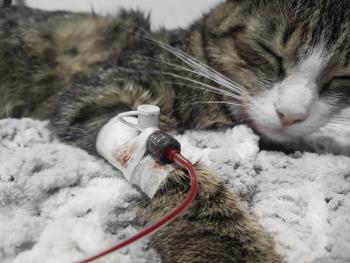
Performing an oil change on a horse
A horse with colic is one of the most common reasons for a veterinarian to go on an after-hours call.
A horse with colic is one of the most common reasons for a veterinarian to go on an after-hours call. It's almost as if the horse knows when you are about to sit down to eat or crawl into bed for the night.
This evening found our family about to sit down to dinner when the phone rang. Dan's horse had a bellyache.
One of the nice things about owning a small-town practice is that you can take the kids on a call if you wish.
Kimmi was about 4 years old and full of questions. She would start asking a new question before you could finish answering the first one. As we left the house together, she started the inquistion before I had backed out of the drive.
"What are we gonna do to the horse, Daddy? Why can't we do it tomorrow? How big is a horse, Daddy?" She went on and on until we got to the clinic.
The horse wasn't in terrible shape as far as colics go, so I decided to give it some pain medicine and tube it with some mineral-oil laxative. This is as common as can be for the problem at hand. You just pass a rubber tube down his nose and into his stomach. Then you pump in about a gallon of mineral oil and simply pull the tube back out. I've done it a thousand times, but Kimmi had never seen anything like it.
I told Dan what I was about to do while Kimmi was rattling off a million more questions. At some point, I sort of tuned the questions out while working, but I was watching her watch me. I wondered what she would think about this operation. Her eyes grew wide as I started down that left nostril with the tube. I wonder why she stopped with the questions at that point. I guess she thought she needed to watch for a couple of minutes before she could form another one.
I got the tube into the stomach and started trying to reflux. Horses can't vomit, so we try to reflux any stomach content before we put in the oil. With this horse, just a small amount of greenish substance came up — nothing to worry about.
But Kimmi was worried.
"Why are you doing that, Daddy? Does the horse have dirty snot? Are you taking it out?" and on and on.
I giggled to myself but didn't have time to answer because it was time to pump in the mineral oil. I began the process, which consists of putting a hand-pumped suction device into the bucket of oil and pumping the stuff directly into the stomach. That started an entirely new volley of questions:
"Are you putting in some clean snot now, Daddy? Do horses need some clean snot when the other gets dirty? Does mine need changing sometimes too, Daddy?"
This line of questioning tickled me, and Dan, too. We didn't really know what to say to a 4-year-old who had no idea one could get to a horse's stomach through its nose.
I tried explaining the procedure, but Kimmi was adamant that the horse had dirty snot and Daddy had changed it, like changing oil.
Dr. Brock owns the Brock Veterinary Clinic in Lamesa, Texas.
Newsletter
From exam room tips to practice management insights, get trusted veterinary news delivered straight to your inbox—subscribe to dvm360.




